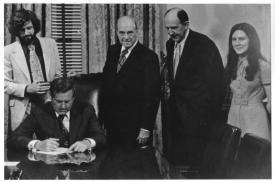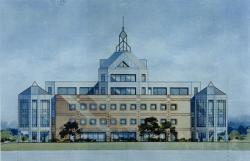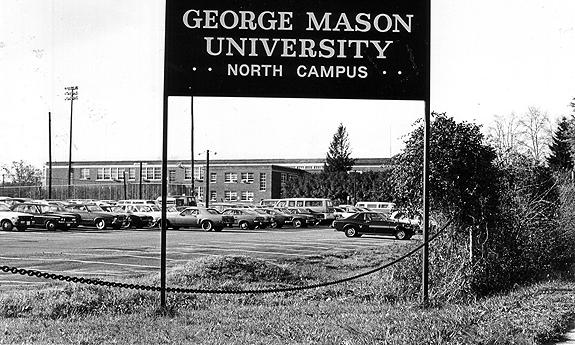The story behind Mason's founding: independence
The following piece is the final of a four-part series on the history of George Mason University. The information and research in this article is based off of “George Mason University: A History,” a project created by University Libraries’ Special Collections & Archives department. The first part of the series is available here. The second is available here. The third is available here.
After the opening of its Fairfax campus in 1964, George Mason College experienced widespread growth in both student enrollment and physical infrastructure. Under Chancellor Lorin A. Thompson’s seven-year tenure, the Fairfax campus grew from 150 to 600 acres, began $10.5 million in construction, and oversaw the completion of ten new campus buildings. Over that same time period, enrollment grew from 840 to 4,200. During the 1970 fall semester, the university introduced graduate programs in biology, education and mathematics.
As a branch college of the University of Virginia, Mason’s top administrators continued to report to UVa officials in Charlottesville through this period of rapid growth. During the college’s expansion, discussion began for separating George Mason College from its parent institution. Surprisingly, Mason’s independence was relatively uncontroversial compared to previous debates between Northern Virginia and Charlottesville.
Plans for independence
The foundations for independence began in the mid-1960s, as Chancellor Thompson planned for the college’s expansion.
A series of reports that outlined the needs of higher education in Northern Virginia recommended that Mason become an independent institution to better address the demands of a growing student-age population.
In the college’s 1968 educational plan, the document described the necessary steps Mason would have to take in order to address demand and thrive as a both an instructional and research institution.
“The challenges of George Mason College will be rapid growth in the next ten years, the need for flexibility to meet demands not foreseen, the capability to preserve gains made, and above all the means to retain the individual dimension of the educational process,” read the document.
 |
| H-210, signed into law on April 7, 1972, officially split Mason from its parent institution (photo courtesy of George Mason University Libraries). |
At the time, UVa was already taking steps to cut loose some of their other remaining branch colleges, including Patrick Henry College in 1971, and Mary Washington College later in 1972.
By 1970, UVa President Edgar F. Shannon and Dr. Roy E. McTarnaghan, director of the State Council of Higher Education, held a long running discussion over the direction of George Mason College and whether to remove it from the UVa system. While Shannon had his reservations, McTarnaghan argued in favor of independence. In February 1972, the UVa Board of Visitors adopted a resolution in favor of independence.
With the Board of Visitor’s recommendation, the Virginia House of Delegates passed bill H-210 on Feb. 11, 1972, reestablishing George Mason College as an independent institution. Passed by the senate on Feb. 23, and signed into law on April 7, the bill also put in place provisions for the George Mason University Board of Visitors, which would replace UVa as the primary decision makers for the university.
“All the real estate and personal property now existing and heretofore standing in the name of the Rector and Visitors of the University of Virginia, located in Fairfax and heretofore exclusively used by the George Mason College Division of the University of Virginia, shall be transferred to and be known and taken as standing in the name and under the control of the Rector and Visitors of George Mason University,” read the bill.
“The separation of George Mason today from UVa marked still another milepost in the university’s rapid growth as a major institution of higher education in the Washington area and as a regional university in Virginia,” read a university press release on the day of the bill’s signing. “Today, George Mason University commands an enrollment of more than 3,000 students enrolled in both undergraduate and graduate degree programs.”
At its inaugural meeting on May 31, 1972, the George Mason University Board of Visitors asked Chancellor Thompson, age 70, to stay on as president of the university for an additional two years. A search committee would be created to find a more permanent president. As chancellor, Thompson laid the foundation for much of the growth that led to Mason’s independence from UVa, and would continue to oversee the institution until the summer of 1973.
From independence to prominence
In the decades following it’s independence, George Mason University would grow from a local community-based college, to a internationally recognized institution offering a wide variety of degrees and programs.
 |
| The University Learning Center, later renamed the Johnson Center, was completed in 1995 (photo courtesy of George Mason University Libraries). |
Mason would continue to build on its original Fairfax campus, eventually adding dormitories, additional class and laboratory space, and the well-recognized Johnson Center, which was completed in 1995 as the University Learning Center and later named after President George W. Johnson. Since its independence, George Mason University has had six presidents.
Mason would also expand its regional prominence, by establishing a law school in Arlington County and other campus in Prince William County and Loudoun County. Even today, Mason continues to grow with its international campus in South Korea.
To read more about the history of George Mason University, visit ahistoryofmason.gmu.edu.

